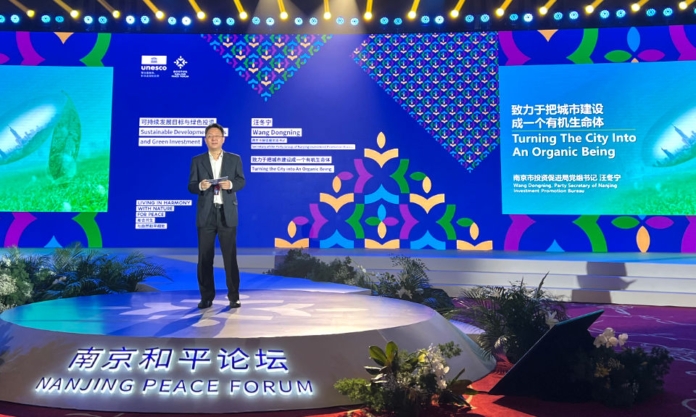Glasgow, Scotland, yesterday, saw COP26 make its first major deal whereby 100 nations of the world committed to ending deforestation by 2030. Ahead of this, on a smaller scale, similar greener futures were also being evidenced here in Nanjing on a local level.
The Nanjing Peace Forum 2021 was held last week from 24 to 26 October. With the theme of, “Living in Harmony with Nature for Peace”, the Forum constituted part of a 3-year MoU between UNESCO and the Nanjing Municipal Government. And this year, sustainability was a significant part of the agenda, with participants and attendees getting to grips with low carbon as not a goal, but a reality.
Ordinarily, many of these kinds of affairs, especially in Nanjing, are heavy on empty words and vague statements, and light on detailed facts. But last week’s Peace Forum could well be a bellwether for change, with the climate crisis’ inevitability now centre stage.
Dr. Mark Wang (Wang Dongning) is Director General and Party Secretary of Nanjing Municipal Investment Promotion Bureau. Wang used the Peace Forum to talk about green construction, energy saving, low carbon, smart city and other sustainable development, citing many inspiring Nanjing examples thereof.
For in China, 50 percent of carbon emissions come from urban and rural construction, as a result of its sheer ubiquity, speed and related industry chain; everything from real estate to landscaping.
All buildings consume huge amounts of energy during their lifetimes. Construction is therefore a massive factor in achieving carbon-neutral goals.
Helping to address this is the so-called “Breathing Tree”, in Nanjing’s Jiangbei New Area, that is the first steel-structure ,low-emission build in Jiangsu Province. Therein, cables and wiring are bundled in the core tube of the building, as in the tree’s trunk. Equipment is situated in the basement, as in the tree’s roots. Intelligent and new energy-powered interiors are the branches and leaves; and glass facades the bark, enabling the building’s photovoltaic power.
Wang also pointed to work underway on what will be the world’s largest underground space, forming the very heart of Jiangbei New Area and serving as foundations for the future’s tallest building in Nanjing, at 499.8 metres in height.
Its importance to achieving carbon-neutral goals was also noted by Qian Qihu, of the Chinese Academy of Engineering. “The development and utilisation of underground space can play an important role in the carbon peak and carbon neutrality, making positive contributions”, said Qian, analysing the relationship between the development and utilisation of underground space, and the green transformation of carbon storage, energy, construction and transportation.
Further afield in Nanjing’s rural Lishui District, Siemens’ digitised plant has installed photovoltaic rooftops across the board and effectively utilised geothermal energy.
Not so far away from the plant is also the zero-carbon, home stay, tourist centre in Lishui, located in Wuxiang Mountain Forest Park. This spring, the centre installed rooftop-photovoltaic tiles and energy-saving lamps, transforming an ordinary building into its zero-emission equivalent.
Then there is the Nanjing National Agricultural High-Tech Zone, working in part to capture carbon dioxide from power stations and then put it to use in local agricultural greenhouses to enable an integrated use of resources.
These are but a few of the 400-odd green projects in Nanjing certified as adhering to national green standards, which can, as Wang hopes, help in “turning the city into an organic being”.
Choosing to give his speech in English, and as former Party Secretary of both Jiangbei New Area and Lishui District, Wang is evidence of a new breed of younger and greener government officials in China. Glasgow and Cop26 would be proud.









